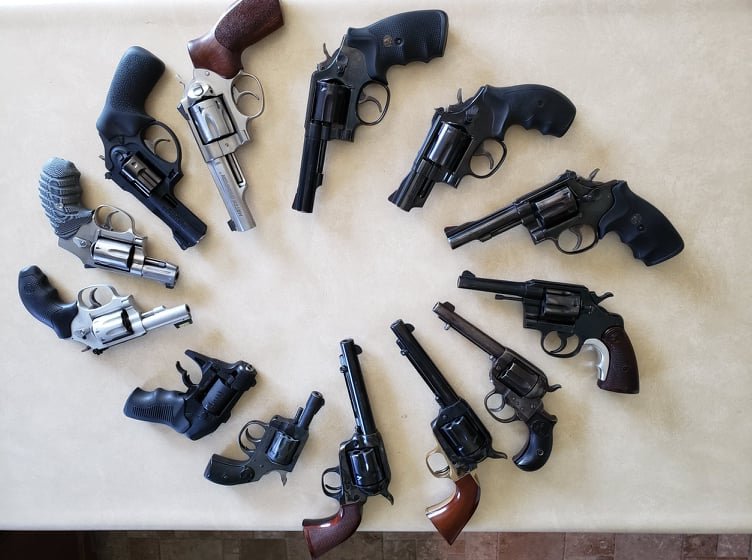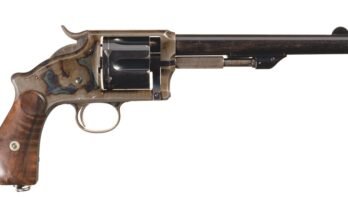Have you ever wondered if revolvers jam less than pistols? If reliability is your top priority, this question might be on your mind every time you pick up a firearm.
Imagine being in a critical moment and your gun failing you—frustrating, right? Understanding how revolvers and pistols perform when it comes to jamming can make a huge difference in your confidence and safety. You’ll discover the key facts that can help you choose the right firearm for your needs.
Keep reading, because what you learn here could change the way you think about your next gun purchase.
Revolver Mechanics
Understanding how revolvers work helps explain why they might jam less than pistols. Revolver mechanics focus on simple, solid design. This simplicity often leads to reliable performance. Let’s explore key features and how revolvers operate.
Basic Design Features
Revolvers have a cylinder that holds several rounds. This cylinder rotates to align each round with the barrel. The mechanism is mostly mechanical, with fewer moving parts. Each part fits tightly to reduce errors. The design avoids complex feeding systems found in pistols. This limits chances of misfeeds or jams.
How Revolvers Operate
Pulling the trigger rotates the cylinder and cocks the hammer. The hammer then strikes the firing pin, igniting the cartridge. Each step is simple and direct. The cylinder moves one round at a time. There is no magazine or spring to push bullets forward. This reduces the risk of feeding problems. Fewer steps mean fewer things can go wrong.
Pistol Mechanics
Pistols have a complex design that affects how they work. Understanding their mechanics helps explain why they might jam.
Pistols use a series of moving parts to load, fire, and eject bullets. Each step must work perfectly to avoid problems.
Key Design Elements
Pistols have several parts that work together. The slide moves back and forth to eject the spent cartridge.
The magazine holds the bullets and pushes each one up to the chamber. The barrel guides the bullet out.
The firing pin strikes the bullet’s primer to fire it. Springs help reset the slide and firing pin.
Small parts like the extractor pull the empty cartridge out of the chamber. The ejector kicks it out.
How Pistols Function
When you pull the trigger, the firing pin hits the cartridge primer. This causes the bullet to fire.
The slide moves back from the recoil. This pushes the empty case out through the ejection port.
The magazine pushes a new bullet into the chamber as the slide moves forward. The gun is ready to fire again.
All parts must work smoothly. Dirt, wear, or bad ammo can cause jams or failures.
Common Causes Of Jamming
Jamming is a common problem in firearms. Both revolvers and pistols can jam, but the reasons differ. Understanding common causes helps reduce jams and improve reliability.
Mechanical Failures
Mechanical failures happen when parts do not move as they should. Pistols have many moving parts, like slides and magazines, increasing failure chances. Revolvers have fewer moving parts, lowering mechanical jam risks. Worn springs, broken extractors, or dirt can cause jams in both guns.
Ammunition Issues
Bad or wrong ammunition often causes jams. Low-quality bullets can get stuck or fail to fire. Pistols are more sensitive to ammo problems because of feeding from magazines. Revolvers hold each bullet in a cylinder, reducing feeding issues. Expired or damaged ammo increases jam chances in all guns.
User Errors
User mistakes are a major cause of jams. Poor maintenance leads to dirt and grime buildup. Incorrect loading of magazines or cylinders causes feeding problems. Rushing or improper handling can cause misfires or jams. Training and care reduce jams caused by user errors.

Jamming Frequency Comparison
Understanding how often revolvers and pistols jam is key to choosing the right firearm. Jamming frequency means how many times a gun stops working during use. This section compares how often revolvers and pistols jam in various conditions. It looks at data and real user stories to give a clear picture.
Statistical Data
Studies show revolvers jam less than pistols overall. Revolvers have a simple design with fewer moving parts. This lowers the chance of mechanical failure. Data from shooting tests reveal pistols jam about 2 to 5 times more often.
Revolvers use a rotating cylinder to hold bullets. This system is less prone to feeding problems, a common cause of jams in pistols. Pistols rely on magazines and slides, which can cause misfeeds or stovepipes.
Ammo quality also affects jamming rates. Both gun types have fewer jams with good bullets. Cheap or damaged ammo raises jamming chances for all firearms.
Real-world Experiences
Many shooters report revolvers as more reliable in tough conditions. Outdoors, dirt and dust cause fewer issues in revolvers. Pistols often jam more in harsh environments.
Some users say pistols need more cleaning to avoid jams. Revolvers still need care but less often. This makes revolvers a favorite for self-defense and law enforcement.
Experienced shooters note that practice and maintenance reduce jams. Knowing how to clear jams fast is crucial for pistol owners. Revolver users face fewer emergency fixes during shooting sessions.
Advantages Of Revolvers
Revolvers have a simple and strong design. They use a rotating cylinder to hold bullets. This makes them stand out from pistols. Many shooters trust revolvers for their ease of use and durability.
The design means fewer parts can break or jam. This gives revolvers a reputation for being reliable. They also require less cleaning and care. These features make them a good choice for many users.
Reliability Factors
Revolvers have fewer moving parts than pistols. The cylinder rotates to bring the next round in line. This system is less likely to fail or jam. Dirt and debris do not affect revolvers as much.
This makes revolvers work well in tough conditions. They are less sensitive to bad ammunition. Even if a round does not fire, the shooter can move to the next one easily. This adds to their trustworthiness in critical moments.
Maintenance Simplicity
Cleaning a revolver is quick and simple. There are no magazines or complex feeding mechanisms. Users can easily access the barrel and cylinder for cleaning. This reduces the time spent on upkeep.
Parts wear less quickly because of the simple design. Fewer replacements and repairs are needed over time. This saves money and effort for the owner. Simple maintenance helps keep the revolver ready to use.

Advantages Of Pistols
Pistols offer several benefits over revolvers. Their design and technology make them popular for many users. These advantages affect how people choose a firearm for different needs.
Capacity And Reloading Speed
Pistols hold more bullets than revolvers. Most pistols carry 10 to 17 rounds in a magazine. Revolvers usually hold 5 to 6 rounds. Reloading a pistol is faster because you swap magazines. Revolver reloading takes more time with each bullet loaded one by one.
Modern Reliability Improvements
New pistols are very reliable today. Advances in materials and design reduce jams and malfunctions. Many pistols have better parts that work smoothly. Some models have special features to avoid common problems. This makes pistols dependable for self-defense and sport shooting.
Situations Affecting Reliability
Reliability of revolvers and pistols can change depending on many factors. These factors affect how often a gun might jam or fail to work properly. Understanding these situations helps in choosing the right firearm for specific needs.
Environmental Conditions
Weather plays a big role in gun reliability. Dirt, dust, and moisture can cause pistols to jam more often. Pistols have many small moving parts that dirt can block. Revolvers have fewer parts exposed, so they handle dirt better.
Cold weather can make lubricants thick. This slows down pistol parts and may cause jams. Revolvers usually work well in cold because of their simple design. Rain or humidity can cause rust. Proper cleaning helps both guns stay reliable.
Type Of Use
How a gun is used affects its reliability. Rapid firing can cause pistols to heat up and jam. Revolvers cool down faster with each shot. Training and practice reduce chances of jams in both types.
Self-defense often means quick, short bursts. Pistols may jam if not well maintained. Revolvers often fire without problems in these moments. For long shooting sessions, pistols may need more care to avoid jams.
Choosing Between Revolvers And Pistols
Choosing between revolvers and pistols depends on many factors. Each type has unique features and benefits. Understanding these can help you pick the right firearm for your needs. Revolvers are simple and reliable. Pistols offer higher capacity and faster reloads. Consider what matters most to you before deciding.
Personal Needs
Your comfort with handling firearms is key. Revolvers have fewer moving parts, making them easier to use. They suit beginners or those wanting a low-maintenance gun. Pistols require more practice to operate well. They fit users who want more rounds and quicker shots. Think about your skill level and how often you will shoot.
Intended Use Cases
Consider why you want a firearm. Revolvers work well for self-defense at close range. Their reliability reduces the chance of jamming in critical moments. Pistols excel in situations needing more ammunition and faster follow-up shots. Law enforcement and sport shooters often prefer pistols for this reason. Match your choice to your main purpose for carrying a gun.

Frequently Asked Questions
Do Revolvers Jam Less Often Than Pistols?
Revolvers jam less due to their simple design and fewer moving parts. Pistols rely on magazines and slides, which can cause more malfunctions. However, proper maintenance affects both types equally.
Why Are Revolvers Considered More Reliable Than Pistols?
Revolvers have a rotating cylinder, reducing feeding issues common in pistols. This mechanical simplicity makes them reliable under various conditions and less prone to jams.
Can Pistols Jam As Frequently As Revolvers?
Pistols can jam more frequently due to magazine feeding problems and slide malfunctions. However, quality pistols with proper upkeep minimize jamming risks significantly.
How Does Ammunition Affect Revolver And Pistol Jamming?
Poor-quality or dirty ammunition increases jamming chances in both revolvers and pistols. Using clean, high-quality rounds reduces malfunction risks for either firearm type.
Conclusion
Revolvers tend to jam less because of their simple design. Pistols have more parts that can fail or get dirty. This makes pistols more likely to jam during use. Still, regular cleaning and good quality ammo help both guns work well.
Choosing between a revolver and a pistol depends on what you need. Think about ease of use, capacity, and maintenance. Both can be reliable with proper care. In the end, knowing how your gun works matters most.



